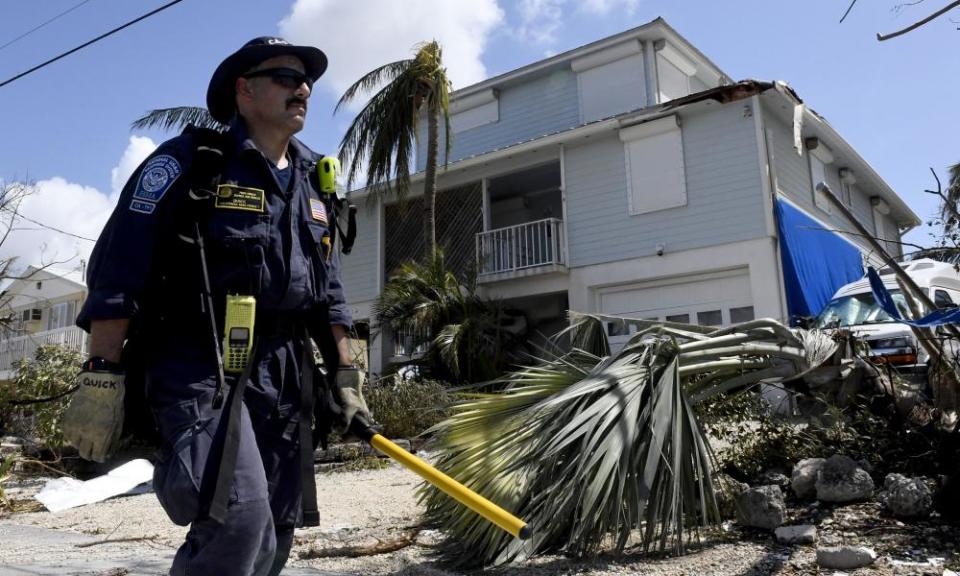Cudjoe Key: the Florida community that was Hurricane Irma's ground zero
Police are retaining a tight grip on the lower Keys as search and rescue teams scour the area and evacuees begin to return, amid an uncertain future

It’s not hard to grasp that Cudjoe Key, a small community of about 1,700 people among the islands of the Florida Keys, was the ground zero of Hurricane Irma.
Speedboats have been lifted like feathers from the sea and deposited on the roadside, camper vans overturned, gas stations flattened.
It was here that Irma first made landfall in Florida on Sunday morning as a mammoth category four hurricane, an event that will forever be etched into the history of Cudjoe.
The eye of the storm passed directly over its 700 or so houses, bringing a brief respite amid a serene and surreal calm, before bulldozing them again with winds of up to 130mph.
Which is why Tony Pothul, 44, emerging from a house right by the southern edge of the key where Irma landed, cut such a strange figure. Surrounded by the debris of the storm all around, Pothul had barely a hair on his head out of place.
Originally from Glasgow in Scotland, he came to live in Cudjoe Key about a year ago and sat out the storm taking care of the house, close to the water, on behalf of the homeowner from Montana.
It’s no surprise that Pothul fared well through a historically powerful hurricane: the house is built like maximum security prison, its concrete living spaces raised on stilts about 30ft above the water line.
Even then, Pothul says, you could feel the house shaking as Irma passed by, her immense energy able to rattle even the sturdiest property.
Perhaps most surprising, Pothul’s two cars, both soft-tops, were utterly untouched. “Smart, huh?” he said. “I parked them on high ground out of the wind.”
Others in Cudjoe Key have not fared so well. When Pothul was visiting a friend nearby in the neighborhood he heard a moaning cry, and approaching a house found that a man was crying for help inside.
The man, who uses a wheelchair, had been flipped on his side during the hurricane and had spent 26 hours on the floor. His wife has Alzheimer’s and was unable to come to his assistance; Pothul found her standing on the porch of the house looking out.
It is the plight of families such as this that emergency authorities are so worried about, labeling the Florida Keys a sight of an unfolding “humanitarian crisis”. When the Guardian visited Cudjoe Key on Wednesday, federal search and rescue teams were scouring residential areas looking for anyone in trouble.
But the signs are that aid is arriving fast. The main highway through the keys, US 1, has now been opened all the way from Key Largo through to Key West, relieving the latter community, which had been entirely cut off, with diminishing resources of water and food.
Evacuees are beginning to return to an uncertain immediate future, amid reports that a quarter of homes in the Keys have been destroyed.
Where lanes have collapsed into the sea, they are now largely patched back together. Several military helicopters, including large supply vehicles, have arrived at the tiny airstrip in Marathon, another heavily damaged part of the keys.
360 degree scene in Cudjoe Key, where the eye of the hurricane made landfall. This is #Irma 's Ground Zero pic.twitter.com/NtO6uCeyHL
— Ed Pilkington (@Edpilkington) September 13, 2017
Florida state police are retaining a tight grip on the lower Keys, however, to allow search and rescue and emergency workers time to do their work without distraction. As you enter the lower Keys, a road sign says: “Curfew dusk to dawn. Zero tolerance.”
Residents of these stricken communities continue to be held back at road blocks in the upper Keys, and the frustration and tension is starting to tell.
At the main roadblock at the entrance to the lower keys, one desperate resident made a dash through the barrier in his car, setting off a police chase with two state trooper vehicles in hot pursuit. Other residents camped out in their cars beside the road, preparing for a very long wait before they would be allowed home.
Betina Charles, 37, originally from Haiti, was trying to get back to Key West, where she cooks Haitian food in a deli called Win Dixie for $10 an hour. She’d spent the past week in a hotel on the mainland, heeding the evacuation order, but has now run out of money and has no idea how she will secure accommodation or food if she isn’t allowed to return home soon.
“I need to get back so I can start working again. No work, no money, no food or nowhere to live, so what am I supposed to do?” she said.
Back at ground zero in Cudjoe Key, Shane Harmon, 47, who works in the tourist business, fared relatively well. With his wife Tami, he sat out the storm in his house close to the water.
The property is also on stilts, and was not badly damaged. The problem he now faces, though, is that both their cars were flooded with the 4ft storm surge that reached their house and are now incapable of being started.
That leaves them stranded with two rusty bicycles, one of which has a wobbly back wheel, and only eight gallons of water remaining. “We listen to the radio, so we know there is a water distribution spot where we could go down the road,” he said.
“The only thing is, it’s five miles away. I’m not sure my cycling skills are up to it.”

